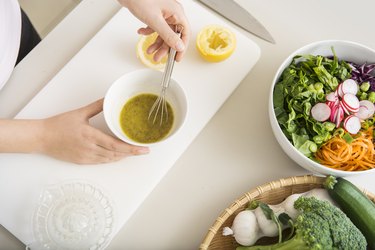
If you've started to cut back on sodium, we totally commend you. But you may find that your food tastes a little bit bland without your saltshaker. And while herbs and spices are always a solid option for adding a little zest to your plate, what do you do once you've exhausted your spice rack?
From fruit juice to vinegar, there are plenty of ways to flavor foods without salt or spices. Here, registered dietitian Laura Burak, RD, CDN, shares tips on how to spice up your tired seasoning routine.
Video of the Day
Video of the Day
1. Natural Juices
You might serve some dishes topped with sliced lemons, but when it comes to jazzing up your plate, fruits can go way beyond the occasional garnish. "Natural juices like lemon and lime bring out and balance the flavor of savory dishes like fish and vegetables like potatoes without any additional calories or sodium," says Burak.
"Plus, citrus fruits are a great source of vitamin C and antioxidants — and when eaten with iron-rich foods like chicken, fish and steak, they enhance the bioavailability and absorption of dietary iron."
To add some sweetness and a refreshing pop of flavor to your dinner, make a marinade with orange juice and pour it over sliced steak. Burak also loves blending sriracha with fresh lime juice, lime zest and maple syrup for a tangy sauce to top salmon. "The acidic lime balances out the spicy and the sweet," she says.
2. Flavorful, Healthy Oils
Rich in heart-healthy monounsaturated fats, oils like olive oil and avocado oil balance out the acidity in sauces, marinades and dressings. Plus, they can help increase the absorption of fat-soluble vitamins A, D, E and K in veggies, says Burak. What's more, diets rich in olive oil, like the Mediterranean diet, are linked to reducing your risk of heart disease, keeping your brain healthy and fighting inflammation.
And, since oil is rich in flavor, a little goes a long way. A simple combo of olive oil, lemon juice and pepper can work wonders on a bowl of raw kale. For a real palate pleaser, Burak suggests drizzling truffle-infused oil over steamed broccoli and a lean cut of steak.
3. Vinegar
"Instead of lemon and lime juice, using different kinds of vinegar like balsamic and red wine vinegar can provide the acid in your sauces, dressings and meals, and can lend a different flavor component to your dishes," says Burak. With all of its zing, vinegar can add gusto to your greens and make it that much easier to eat more veggies.
And, since vinegar contains so few calories, it's a great option for people watching their caloric intake and don't want to sacrifice the flavor in their food.
4. Honey and Maple Syrup
You might squeeze a hint of honey into your tea or douse your pancakes with maple syrup, but have you ever thought to use these natural sweeteners as meat glazes?
Packing powerful antioxidants, honey and maple syrup make the perfect accompaniments to savory meat dishes, says Burak. Specifically, they offer a sweet contrast to salty marinades for chicken and fish. But honey and maple syrup also pair well with vegetables like crispy Brussels sprouts since they balance out the cruciferous veggie's bitterness.
5. Salad Dressings
If you're only drizzling dressing on your salads, you're missing out. Versatile and flavorful, salad dressings can act as mouthwatering marinades or scrumptious sauces for meats, poultry and fish, says Burak.
What's more, you can easily whip up a simple salad dressing from scratch by combining heart-healthy olive oil with vinegar or lemon and lime juice and fresh herbs. Store-bought brands can do the trick, too — just remember to read the nutrition label to make sure your bottle is low in sodium.